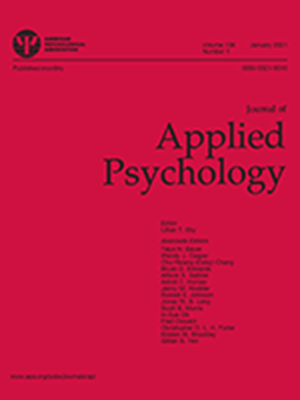别人能(不能)看到的东西真的重要吗?领导竞技场-声誉-身份(LARI)模型与领导者效能之间的关系。
IF 9.4
1区 心理学
Q1 MANAGEMENT
引用次数: 0
摘要
领导力学者们认识到,掌握领导者如何看待自己以及他人如何看待自己是很有价值的。最近,领导力竞技场-归因-认同(LARI)模型被提出来,作为一种更精确地捕捉多源领导力评级所依据的共同和独特视角的方法。尽管该模型有其优势,但仍有几个与之相关的关键问题没有得到解答:(1)LARI 模型所提供的大量信息对领导者的有效性有影响吗?(2) 在 LARI 模型中,某一特定来源所解释的变异量是否取决于所评价的领导力维度的可观察性?(3) LARI 模型是否可以推广到企业的高层(即高级管理人员),同时也能兼顾其他来源效应(即董事会成员)?通过对 491 名高级管理人员的领导能力进行多源评级,以及对其有效性进行基于团队的评估,我们首先从概念上和实证上扩展了可容纳预测关系的模型 1,即 LARI(S-1)模型,然后发现 LARI(S-1)模型作为领导能力多源评级的概念化手段(即使在不同的背景和额外的评级来源下)也能发挥良好的作用。我们还发现,LARI(S-1)模型捕捉到了领导者有效性的重要变化,有时甚至是很大一部分变化。我们的研究结果还表明,特定的领导力评级来源对领导者有效性的预测程度部分取决于所评估的领导力维度的可观察性。本文讨论了研究的意义和未来发展方向。(PsycInfo Database Record (c) 2024 APA, 版权所有)。本文章由计算机程序翻译,如有差异,请以英文原文为准。
Does what others can(not) see really matter? The relationship between leadership Arena-Reputation-Identity (LARI) model and leader effectiveness.
Leadership scholars recognize that there is value in capturing how leaders view themselves and how they are viewed by others. Recently, the leadership Arena-Reputation-Identity (LARI) model has been advanced as a means of more precisely capturing the shared and unique perspectives that underlie multisource ratings of leadership. Despite its strengths, several critical questions pertaining to this model remain unanswered: (1) Does the wealth of information provided by the LARI model have any bearing on the effectiveness of a leader? (2) Does the amount of variance explained by a particular source within the LARI model depend on the observability of the leadership dimension being rated? (3) Does the LARI model generalize to the upper echelon of the firms (i.e., senior executives) while also accommodating additional source effects (i.e., board members)? Drawing on multisource ratings of 491 senior executives' leadership competencies, as well as a team-based assessment of their effectiveness, we first conceptually and empirically extend this Model 1 that can accommodate predictive relationships, that is, LARI (S-1) model, and then find that the LARI (S-1) model functions well as a means of conceptualizing multisource ratings of leadership (even in a distinct context and additional sources of ratings). We also find that the LARI (S-1) model captures a significant, and at times, substantial portion of variability in leader effectiveness. Our results also suggest that the extent to which a particular source of leadership ratings predicts a leader's effectiveness is based, in part, on the observability of the leadership dimension being assessed. Implications and future directions are discussed. (PsycInfo Database Record (c) 2024 APA, all rights reserved).
求助全文
通过发布文献求助,成功后即可免费获取论文全文。
去求助
来源期刊

Journal of Applied Psychology
Multiple-
CiteScore
17.60
自引率
6.10%
发文量
175
期刊介绍:
The Journal of Applied Psychology® focuses on publishing original investigations that contribute new knowledge and understanding to fields of applied psychology (excluding clinical and applied experimental or human factors, which are better suited for other APA journals). The journal primarily considers empirical and theoretical investigations that enhance understanding of cognitive, motivational, affective, and behavioral psychological phenomena in work and organizational settings. These phenomena can occur at individual, group, organizational, or cultural levels, and in various work settings such as business, education, training, health, service, government, or military institutions. The journal welcomes submissions from both public and private sector organizations, for-profit or nonprofit. It publishes several types of articles, including:
1.Rigorously conducted empirical investigations that expand conceptual understanding (original investigations or meta-analyses).
2.Theory development articles and integrative conceptual reviews that synthesize literature and generate new theories on psychological phenomena to stimulate novel research.
3.Rigorously conducted qualitative research on phenomena that are challenging to capture with quantitative methods or require inductive theory building.
 求助内容:
求助内容: 应助结果提醒方式:
应助结果提醒方式:


